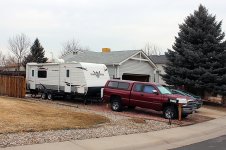Fact is that no matter how capable the SRW is, the DRW drivers want you to have a DRW vehicle whether or not you want or need it. No matter how capable the 3500 becomes, this argument will continue.
As far as SAE is concerned, they require service factors to be employed in designs. So given SAE design requirements a 3500 operating at max is operating within design parameters. In fact, slightly over loaded is out of design parameters but still within service factors.
My towing accounts for 25% of the current milage on my truck. At this rate the my truck will tow 50,000 miles out of 200,000 miles of service. I dont think that anyone can make the case that 50,000 miles towing at max or slightly above is going to destroy a 3500. Mountain passes or not. The truck is designed to operate at capacity every day of its working life by the manufacturer.
The main argument is not surrounded by the fact that for a few bucks more you can have a DRW, but rather do people want to operate, maintain and provide insurance for a DRW for the 75% of the time the TV is not towing? The difference in cost of ownership far exceeds the the small difference in price to buy the option of a DRW. Your insurance company is charging you for insuring a truck that has a GVWR such as a DRW and they are assuming that you are operating it that way all the time. So when you are adding up all the expenses you will find out you are paying dearly for the small benefit you gain from the DRW vehicle.
I find it interesting, that many on this forum will buy cheap Chinese ST tires for their rigs that have no service factors built in, and blowout on a routine basis, then turn right around and tell you that you must far surpass your requirements for a tow vehicle because you might be a little beyond payload rating on a SRW.
If the math works and you are within GCVW and at max on payload, then you are well within design parameters. SAE design specs have already factored that into your ratings. And those design parameters include continuous use as well.

